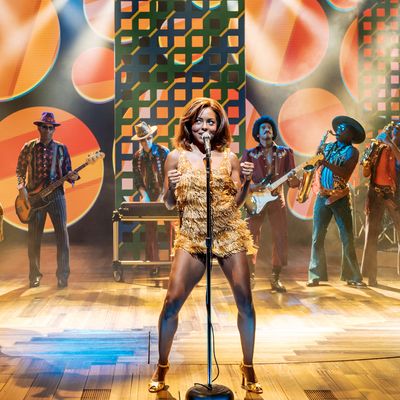
One of the many astonishing things about Tina Turner is the way she could be in two places at once. Somehow, even when she was singing lead, she was also dancing her own backup. If you YouTube her old performances, you can watch her sing “Proud Mary” in that trumpet-of-victory voice, then, between verses, dash back into line with the Ikettes to join their hyperamped unison work, which she had often choreographed herself. The dancers’ feet go like jackhammers, and they slap their legs and the air as though they’re beating out invisible fires. She races back to her microphone, then leaps into the line again. This is Turner the superworker, the woman who never quit, the singer who went to the top in five different decades. Now that she is more or less retired in Switzerland, the point of Tina: The Tina Turner Musical is to set those fires once again. Can we feel that same excitement and energy and vicarious resilience while watching someone pretend to be her?
At rest, Adrienne Warren doesn’t seem like she could ever play Turner—she’s tiny, for one thing, and her face is more 1920s silent-movie heroine than Tina’s smiling tiger. But when she’s moving, she overcomes all that. For more than two and a half hours, barely with a second offstage, Warren is Pure Work. At one point we see Warren from behind as she’s climbing a staircase, and it’s like watching a Leonardo da Vinci diagram walk away from you: Each muscle has been drawn in ink; her rippling back could support wings. The impersonation itself isn’t perfect. After a run of scenes speaking in Turner’s distinctive voice, Warren sometimes sounds like she’s lapsing into “cartoon old lady” instead of Turner’s sandy rasp. But who cares? It’s never a barrier, and it’s all forgotten the moment she sings. Director Phyllida Lloyd has built long, multiscene sequences in Tina that crash like waves, massive song after mammoth hit after monster performance. Warren doesn’t bear up under them—she rises up and smashes down too. She’s gigantic. She’s tidal.
The musical that’s assembled around these tsunamis is … okay. (It doesn’t need to be much more—practically speaking, it just needs to deliver us into the hands of a number like “The Best,” which can certainly take it from there.) The book was written by Katori Hall with Frank Ketelaar and Kees Prins, and while any collaboration is a subtle mystery, that seems like a lot of cooks. Act One steers us in flashback from Anna-Mae Bullock’s difficult childhood through her “discovery” and rechristening by Ike Turner (Daniel J. Watts), their joint career in the 1960s and ’70s, and his long years of abuse and her eventual escape. Act Two takes us down the comeback path, from Vegas to London to her mother’s deathbed and a climactic, definitive rejection of Ike. Its dénouement takes place in 1988, at Tina Turner’s record-breaking concert in Rio—the same place where the show began. It’s not clear why the Brazil concert became the framing device, but then biographical shows always have trouble ending. Lives aren’t stories.
Speaking of that uncomfortable fact, Hall also wrote The Mountaintop, in which Martin Luther King, Jr. is visited by an angel on the eve of his death, and there are a few sequences here that remind me, uncomfortably, of that play. Tina starts with an awkward Ghosts of Christmas Past moment, in which Tina-in-Brazil, meditating before her show, is visited by pale visions of her Gran Georgeanna (Myra Lucretia Taylor) chanting “Yo ho ha nay”—the family claims Cherokee ancestry—and her preacher father (David Jennings), ringing a bell to call his congregation to church. In content and execution, the moment is tacky. Later, during a second act find-your-defining-outfit sequence, Tina is visited by a blue-lit spirit of her child self (Skye Dakota Turner), who reverently passes her a wig as though she’s handing off Excalibur. First of all, a child-self turning up to help an adult-self thing was goofy in Rocketman, and it’s goofy here; second, it accidentally tips a nice makeover moment into parody.
But, as I say, it hardly matters. The book moves us through Turner’s stations of the cross, and at each one, songs rise. We get a sense of the power in young Anna-Mae when ten-year-old Skye Dakota Turner’s single voice drowns out an entire church service, though her mother Zelma (the great Dawnn Lewis) tries to shush her. (There is no shushing this girl: During the finale, the little phenom manages to out-sing the cast, the guitar section, two percussionists, and a theater of screaming fans. You can hear this kid in space.) Warren swiftly takes over as Bullock reaches her teen years, and we’re treated to a sweet and wild version of “Shake a Tailfeather,” the first time we realize how Lloyd and her choreographer Anthony Van Laast plan to blow our minds. They seem to be using the visual equivalent of the Phil Spector “Wall of Sound,” which comes up a few scenes later when he records Turner for “River Deep—Mountain High.” Spector aimed to overwhelm the ear with sheer muchness, and Lloyd and Van Laast use their huge company to do the same thing to the eye. Everywhere you look there is movement and character work and razzle-dazzle. These are the sections in my notes where I just give up writing things down entirely.
Lloyd isn’t afraid of an empty stage, though. Projections designer Jeff Sugg gives her many different scenes of painterly loveliness, which she uses to powerful effect. To take just a few: Ike and Tina on a lonely highway in Mississippi, a smeared and misty motel in the distance; Tina, roaring “River Deep” alone in Phil Spector’s studio, while the walls pulse with visible sound waves. These moments often tell the more painful story, the lonelier story, than the triumphal one with its cast of thousands. Hall and Lloyd make sure we know that racism was another abuser in Tina’s life: The Ike and Tina Revue is outside that motel because the white desk clerk won’t let them in. Bigoted record executives are still ignoring and insulting her well into the 1980s, and when she battles back to stardom, she and her children are living in poverty. It’s these villains—Ike in the first half, white power structures in the second—that give the musical its thrust. (Watts was even booed a bit at his bow, like a melodrama baddie.) Thanks, in a way, to these clearly cruel antagonists, Tina is most cohesive of the divographies of the last few years.
The show rests on three pillars: the excellent production, the most galvanizing catalogue in showbiz, and Adrienne Warren. In the first case, Lloyd’s team includes sound designer Nevin Steinberg and a musical team—conductor Nicholas Skilbeck arranging and composing extra music and Ethan Popp doing the orchestrations—who make everything powerful without simply cranking the volume. The second feels undeniable; there’s so much uplift in that theater you can feel the building settle back onto its foundations after the show. And the third? Warren is doing something everybody, everywhere should try to come see. But on Wednesday afternoons and Sundays, Tina is played by Nkeki Obi-Melekwe, and I bet she’s a life-changer too. I think of Tina Turner herself, running back into line so she can dance with the others. The burden of this show is so great that it’s like some kind of sacred test: Anyone who can pick up the lightning bolt might be a god.
Tina: The Tina Turner Musical is at the Lunt-Fontanne Theatre.


